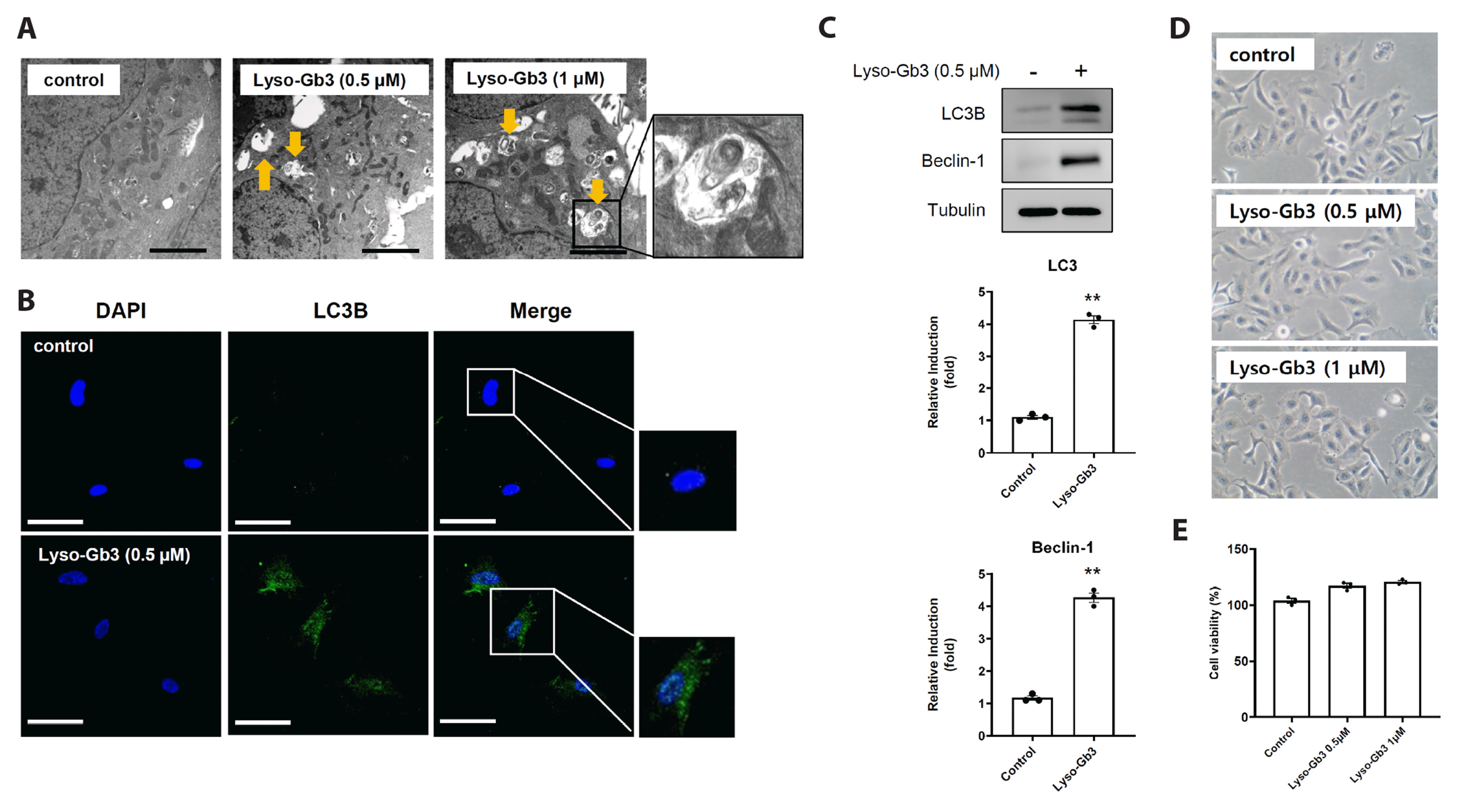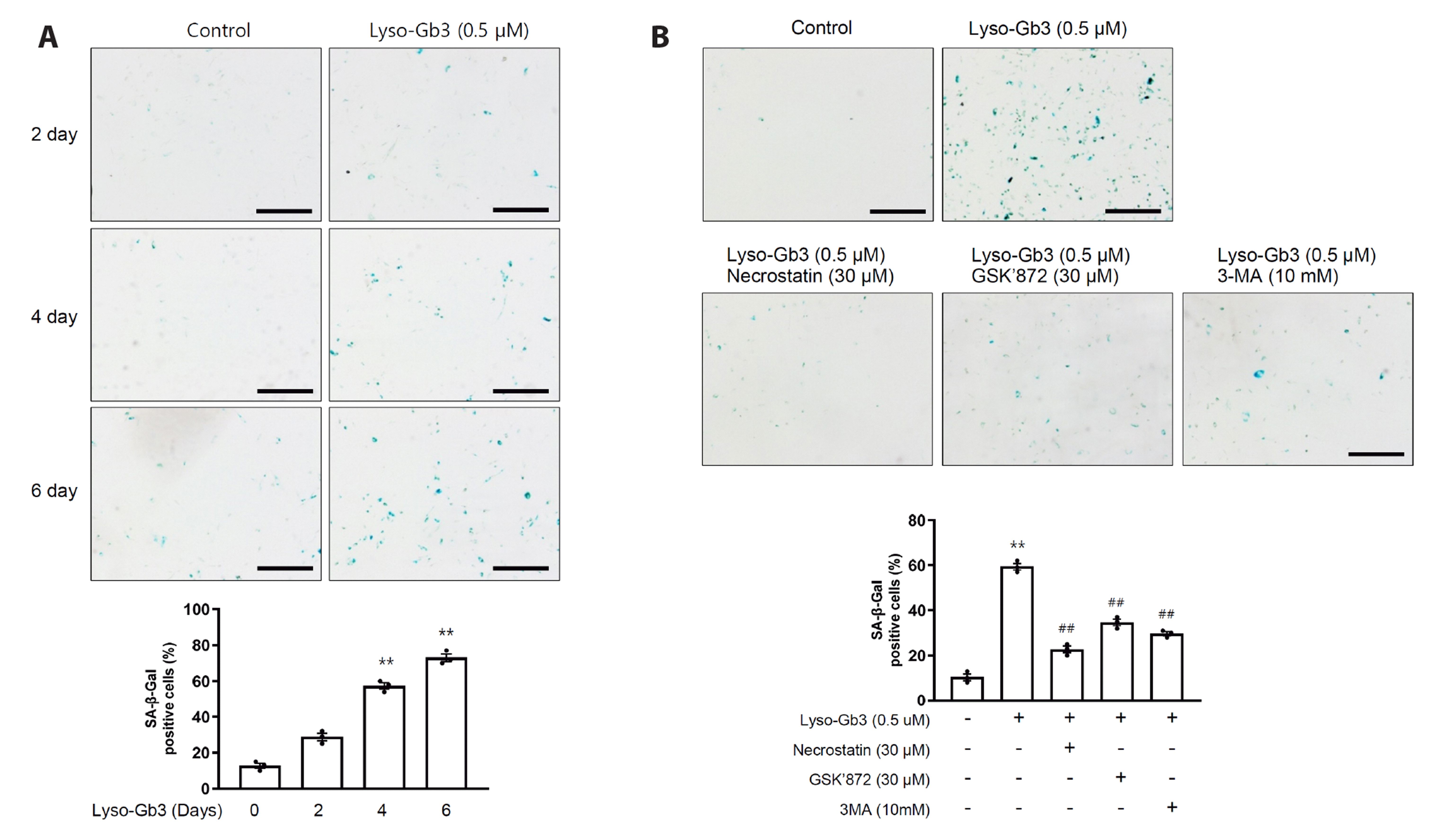INTRODUCTION
METHODS
Reagents and antibodies
Cell culture and treatment conditions
Western blot analysis
MLKL oligomerization
Real time quantitative reverse transcriptase polymerase chain reaction (qRT-PCR)
Immunofluorescence analysis
Senescence-associated β-galactosidase (SA-β-gal) staining
Enzyme-linked immunosorbent assay (ELISA)
Transmission electron microscopy (TEM)
Treatment of HUVECs with conditioned media (CM)
Statistical analysis
RESULTS
Lyso-Gb3 induced autophagy in ARPE-19 retinal pigment epithelial cells
 | Fig. 1Lyso-Gb3 induces autophagy in ARPE-19 cells.(A) ARPE-19 cells were exposed to the indicated concentrations of lyso-Gb3 for 24 h. Transmission electron microscopic image of an autophagosome. Scale bar, 1 μm. (B) ARPE-19 cells were pretreated with 3-MA (10 mM) for 1 h and then incubated with lyso-Gb3 (0.5 μM) for 24 h. Autophagy was confirmed by indirect immunofluorescent staining using LC3 antibodies. Nuclei were stained with DAPI. Images were captured at an original magnification of ×600. Scale bar, 50 μm. (C) ARPE-19 cells were exposed to lyso-Gb3 (0.5 μM) for 24 h, and protein expressions were assessed by immunoblotting with anti-LC3B, anti-beclin-1, and anti-tubulin antibodies. Results are representative of three independent experiments. Bar graphs show densitometric quantifications of Western blot bands. (D) Cellular morphologies were observed under a light microscope using the same conditions. (E) Cell viabilities were determined using an MTT assay under the same conditions. Results are representative of three independent experiments. 3-MA, 3-Methyladenine. **p < 0.01 vs. vehicle controls, one-way ANOVA followed by Bonferroni’s post-hoc test.
|
Lyso-Gb3 induced necroptosis and inflammation in an autophagy-dependent manner in ARPE-19 cells
 | Fig. 2Lyso-Gb3 induces necroptosis in an autophagy-dependent manner in ARPE-19 cells.(A) ARPE-19 cells were exposed to the indicated concentrations of lyso-Gb3 for 24 h. Protein expressions were determined by immunoblotting with anti-RIP1, anti-RIP3, anti-MLKL, and anti-tubulin antibodies. Bar graphs show densitometric quantifications of Western blot bands. (B) ARPE-19 cells were first incubated with 3-MA (10 mM) for 1 h and then incubated with lyso-Gb3 (0.5 μM) for 24 h. Protein expression was determined by immunoblotting with anti-LC3, anti-beclin-1, anti-RIP1, anti-RIP3, anti-MLKL, and anti-tubulin antibodies. Bar graphs present densitometric quantifications of Western blot bands. (C) ARPE-19 cells were first incubated with 3-MA (10 mM) for 1 h and then incubated with lyso-Gb3 (0.5 μM) for 24 h. The cell lysates were resolved on non-reducing gel and analyzed by immunoblotting with anti-MLKL antibody. (D) The mRNA expressions of RIP1, RIP3, and MLKL were determined by quantitative real time-PCR analysis in ARPE-19 cells treated with lyso-Gb3 in the presence or absence of 3-MA (10 mM). qRT-PCR analysis was performed in triplicate. (E) ELISA assay was conducted to analyze the effect of 3-MA on IL-1β, IFN-γ, and TNF-α secretion by lyso-Gb3. ARPE-19 cells were pretreated with 3-MA (10 mM) for 1 h, followed by 24-h incubation with lyso-Gb3 (0.5 μM). (F) ARPE-19 cells were first incubated with 3-MA (10 mM) for 1 h and then incubated with TNF-α (5 ng/ml), IL-1β (10 ng/ml) and IFN-γ (10 ng/ml) for 24 h. Protein expressions were determined by immunoblotting with anti-RIP1, anti-RIP3, anti-MLKL, and anti-tubulin antibodies. Bar graphs show densitometric quantifications of Western blot bands. The results represent three independent experiments. 3-MA, 3-methyladenine; TNF-α, tumor necrosis factor α; IL, interleukin; IFN-γ, interferon gamma. *p < 0.05 and **p < 0.01 vs. vehicle controls, #p < 0.05 and ##p < 0.01 vs. lyso-Gb3 treated cells and pro-inflammatory cytokine treated cells, one-way ANOVA followed by Bonferroni’s post-hoc test.
|
CM from lyso-Gb3 treated ARPE-19 increased endothelial necroptosis and inflammation
 | Fig. 3Conditioned media of lyso-Gb3 treated ARPE-19 cells increases endothelial necroptosis and inflammation.(A) Schematic view of the experiment design. (B–D) ARPE-19 cells were pretreated with necrostatin (30 μM), GSK’872 (30 μM), or 3-MA (10 mM) for 1 h and then incubated with lyso-Gb3 (0.5 μM) for 3 h. Media were then replaced with fresh medium. After overnight (O/N) incubation, the conditioned medium (CM) was recovered and then transferred to HUVECs for further incubation for 24 h. ARPE-19 cells and HUVECs were immunoblotted using anti-RIP1, anti-RIP3, anti-MLKL, anti-LC3, anti-beclin-1, anti-VCAM-1, anti-ICAM-1, and anti-tubulin antibodies. Bar graphs show densitometric quantifications of Western blot bands. 3-MA, 3-methyladenine; HUVEC, human umbilical vein endothelial cell. *p < 0.05 and **p < 0.01 vs. vehicle controls, #p < 0.05 and ##p < 0.01 vs. lyso-Gb3 treated cells, one-way ANOVA followed by Bonferroni’s post -hoc test.
|
CM of lyso-Gb3 treated ARPE-19 cells increased endothelial senescence
 | Fig. 4Conditioned media from lyso-Gb3 treated ARPE-19 cells increases endothelial senescence.(A) Endothelial senescence was assessed by senescence-associated β-galactosidase (SA-β-Gal) staining in HUVECs treated with conditioned medium (CM) from lyso-Gb3 treated ARPE-19 cells. (B) The effects of necrostatin, GSK’872, or 3-MA on lyso-Gb3 treated ARPE-19 CM-induced HUVEC senescence as determined by SA-β-Gal assays. Images are representative of three independent experiments (B). Scale bar, 50 μm. Bar graphs show expressions as mean percentages of SA-β-Gal positive cells. 3-MA, 3-methyladenine; HUVEC, human umbilical vein endothelial cell. **p < 0.01 vs. vehicle control, ##p < 0.01 vs. lyso-Gb3 treated cells, one-way ANOVA followed by Bonferroni’s post-hoc test.
|




 PDF
PDF Citation
Citation Print
Print


 XML Download
XML Download